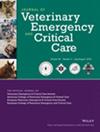Associations Among Various Physical Parameters and the Axillary-to-Rectal Temperature Difference in Dogs and Cats
Abstract
Objective
To compare the measurement of axillary temperature (AT) with rectal temperature (RT) in dogs and cats and to identify the influence of physical parameters on the difference between their measurement using a veterinary-specific thermometer.
Design
Prospective study (2022–2024).
Setting
University teaching hospital.
Animals
A total of 106 dogs and 101 cats aged ≥4 months.
Interventions
Body temperatures were measured contemporaneously using a veterinary-specific, calibrated, dual-thermistor axillary thermometer (AT) and a calibrated medical thermometer (RT). Data were evaluated for bias as a whole set and after stratification based on various physical parameters (species, body weight, haircoat length, body condition score [BCS]). A machine learning (ML) model was subsequently applied, and bias was reevaluated.
Measurements and Main Results
A Bland–Altman analysis comparing the measurement of AT with RT showed a bias of 1.01°C (1.82°F) and 95% limits of agreement (LOA) −0.66°C to 2.68°C (−1.19°F to 4.83°F) in dogs and a bias of 0.23°C (0.42°F) and 95% LOA of −2.61°C to 3.08°C (−4.71°F to 5.55°F) in cats. Animals weighing <10 kg had a bias of 0.33°C (95% LOA: −2.29°C to 2.96°C), animals with BCS <5 had a bias of 0.09°C (95% LOA: −2.92°C to 3.11°C), and those with shorter haircoats had a bias of 0.49°C (95% LOA: −2.03°C to 3.00°C). The ML model overestimated RT when using AT and physical parameters in its algorithm (dogs: −0.57°C [95% LOA: −2.18°C to 0.99°C]; cats −0.84°C [95% LOA: −2.62°C to 0.93°C]).
Conclusions
Animals weighing <10 kg, with lower BCS, and shorter haircoats had less bias when AT was compared with RT. Cats exhibited a lower bias between AT and RT than dogs. ML models can be programmed to account for various physical characteristics, improving the predictive impact of AT for directly measured RT, especially in categories of animals where closer prediction does not already exist.


 求助内容:
求助内容: 应助结果提醒方式:
应助结果提醒方式:


